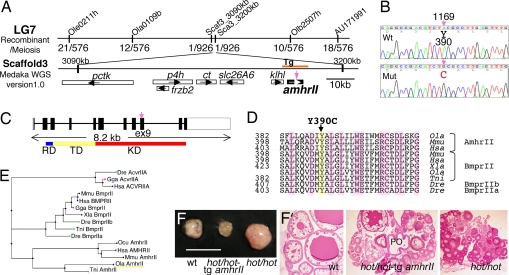Fig. 4.
Characterization of the hot mutation. (A) Genetic mapping of the hot mutation using polymorphic markers. Genetic map of medaka linkage group 7, indicating the recombination frequency of the hot mutation with markers that place this mutation in Scaffold 3 [Medaka Whole-Genome Shotgun (WGS) sequencing project, version 1.0]. Genes: pctk, PCTAIRE-motif protein kinase; p4h, prolyl-4-hydroxylase; ct, creatine transporter; slc26A6, solute carrier family 26, member 6; klhl, kelch-like protein. (B) A missense mutation (TAC to TGC) has occurred in exon 9 of the amhrII gene, causing an amino acid substitution (Tyr to Cys) in the intracellular kinase domain. (C) Schematic representation of the amhrII gene and the position of the hot mutation. RD, activin types I and II receptor domain; TD, transmembrane domain; KD, serine/threonine protein kinase domain. The hot mutation in amhrII gene exon 9 is indicated by a vertical arrow. (D) Comparisons of the deduced amino acid sequences of the medaka and mammalian AmhrII, and of the BmprII proteins of various vertebrate species. Note that the mutated Tyr residue in hot is conserved among the type II receptors and across the species shown. (E) Phylogenetic relationship between the medaka AmhrII with other type II receptors of the TGF-β superfamily. Dre, Danio relio (zebrafish); Gga, Gallus gallus (chicken); Hsa, Homo sapiens (human); Mmu, Mus musculus (mouse); Xla, Xenopus laevis; Tni, Tetraodon nigroviridis (pufferfish); Ocu, Oryctolagus cuniculus (rabbit); Ola, O. latipes (medaka). (F) Rescue of the hot-homozygous phenotype by expression of a wild-type amhrII transgene. The hyperproliferation of germ cells in the ovary was inhibited in the transgenic fish at 3 months of age. (Left) Wild-type ovary. (Center) hot/hot XX fish harboring the amhrII transgene. (Right) hot/hot XX fish. (Scale bar, 10 mm.) (F′) Sections of the ovaries shown in F. In the hot/hot XX fish carrying the amhrII transgene, the number of growing follicles is reduced compared with the hot-homozygous ovary, and postovulatory follicle is also observed (PO).

